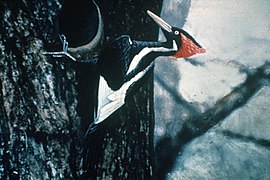Datel knížecí
 Datel knížecí na ručně dobarvené, původně černobílé fotografii z roku 1935 | |
| Stupeň ohrožení podle IUCN | |
 kriticky ohrožený druh[1] | |
| Vědecká klasifikace | |
| Říše | živočichové (Animalia) |
| Kmen | strunatci (Chordata) |
| Podkmen | obratlovci (Vertebrata) |
| Třída | ptáci (Aves) |
| Podtřída | letci (Neognathae) |
| Řád | šplhavci (Piciformes) |
| Čeleď | datlovití (Picidae) |
| Rod | datel (Campephilus) |
| Binomické jméno | |
| Campephilus principalis (Linné, 1758) | |
| Poddruhy | |
| |
| Synonyma | |
| |
| Některá data mohou pocházet z datové položky. | |
Datel knížecí (Campephilus principalis) je jeden z největších šplhavých ptáků světa.
Popis
Dosahuje až 51 cm na délku a rozpětí křídel činí až 76 cm. Samec je černý s červenou chocholku, ruční letky jsou bílé, od hřbetu po tvářích mají bílé pruhy. Samice oproti samcům mají černou chocholku. Obě pohlaví mají slonovinově zbarvený zobák (také tomu napovídá i anglický název Ivory billed woodpecker), což lze přeložit jako datel slonovinozobý.
Výskyt
Jeho domovem jsou pralesy na jihovýchodě Spojených států amerických, samostatný poddruh žije také na Kubě.
Ohrožení a status
V roce 1920 byl datel knížecí považován za vyhynulý druh, o 24 let později byla ve zbytku lesa spatřena samice. Příčinou vyhynutí byla nadměrná těžba dřeva. Ubývání přirozeného prostředí a v menší míře také lov ztenčily jeho stavy natolik, že není jasné, zda vůbec nějaký jedinec ještě přeživá. V současnosti v podstatě neexistují lesní porosty, které by byly schopné udržet životaschopnou populaci datla knížecího. Druh je Mezinárodním svazem ochrany přírody klasifikován jako kriticky ohrožený, přičemž je považován za pravděpodobně vyhynulý.
Galerie
Campephilus principalis
Campephilus principalis
Campephilus principalis
Campephilus principalis
Campephilus principalis
Odkazy
Reference
- ↑ Červený seznam IUCN ohrožených druhů 2021.3. 9. prosince 2021. Dostupné online. [cit. 2021-12-27]
Externí odkazy
 Obrázky, zvuky či videa k tématu datel knížecí na Wikimedia Commons
Obrázky, zvuky či videa k tématu datel knížecí na Wikimedia Commons  Taxon Campephilus principalis ve Wikidruzích
Taxon Campephilus principalis ve Wikidruzích
Média použitá na této stránce
Autor:
- Information-silk.png: Mark James
- derivative work: KSiOM(Talk)
A tiny blue 'i' information icon converted from the Silk icon set at famfamfam.com
Autor: Daderot, Licence: CC0
Taxodermic bird specimen in the Fairbanks Museum and Planetarium, St. Johnsbury, Vermont, USA.
Autor: Original photo by Arthur A. Allen, 1935 [1], watercolored by Jerry A. Payne, USDA-ARS, Licence: CC BY 3.0 us
Male Ivory-billed Woodpecker. Believed to be extinct in the 1960-70's in the United States, but found in Cuba in 1980's. Photo by Arthur A. Allen, 1935, watercolored by Jerry A. Payne, United States Department of Agriculture (USDA) - Agricultural Research Service (ARS).
Autor: James St. John, Licence: CC BY 2.0
Campephilus principalis (Linnaeus, 1758) - male ivory-billed woodpecker (mount, Carnegie Museum of Natural History, Pittsburgh, Pennsylvania, USA).
Recorded calls & possible sightings of the ivory-billed woodpecker in southern America in recent years have been received with much excitement by ornithologists & the general public (listen to a genuine 1935 recording made in Louisiana - www.birds.cornell.edu/ivory/multimedia/sounds/knownsounds...) (listen to a 2005 recording made in Arkansas - turn up your computer speaker - www.birds.cornell.edu/ivory/multimedia/sounds/arkansasken...). The species, Campephilus principalis, has been considered extinct or near-extinct for much of the 20th century. It originally lived in southeastern America and Cuba (mitochondrial DNA analysis has suggested that the extinct or near-extinct Cuban form is a distinct species, Campephilus bairdii; the ivory-billed woodpecker, the Cuban ivory-billed woodpecker, and the imperial woodpecker (Campephilus imperialis) diverged from each during the late Early Pleistocene, at about 1 m.y. ago; see Fleischer et al., 2006, Biology Letters 2: 466-469).
The ivory-bill is a very large, black-and-white woodpecker that resembles another large bird, the still-living pileated woodpecker (Dryocopus pileatus - www.lies.com/wp/images/pileated.jpg). The adult male ivory-bill has a wedge of intense red coloration at the back of the head. Juvenile and the female ivory-bills lack the reddish-colored wedge.
Classification: Animalia, Chordata, Vertebrata, Aves, Piciformes, Picidae
Birds are small to large, warm-blooded, egg-laying, feathered, bipedal vertebrates capable of powered flight (although some are secondarily flightless). Many scientists characterize birds as dinosaurs, but this is consequence of the physical structure of evolutionary diagrams. Birds aren’t dinosaurs. They’re birds. The logic & rationale that some use to justify statements such as “birds are dinosaurs” is the same logic & rationale that results in saying “vertebrates are echinoderms”. Well, no one says the latter. No one should say the former, either.
However, birds are evolutionarily derived from theropod dinosaurs. Birds first appeared in the Triassic or Jurassic, depending on which avian paleontologist you ask. They inhabit a wide variety of terrestrial and surface marine environments, and exhibit considerable variation in behaviors and diets.The male Ivory-Bill leaves as the female returns. Photo taken in Singer Tract, Louisiana by Arthur A. Allen (April 1935). From Recent observations of the Ivory-Billed Woodpecker (Auk) Volume 54, Number 2, April, 1937.








